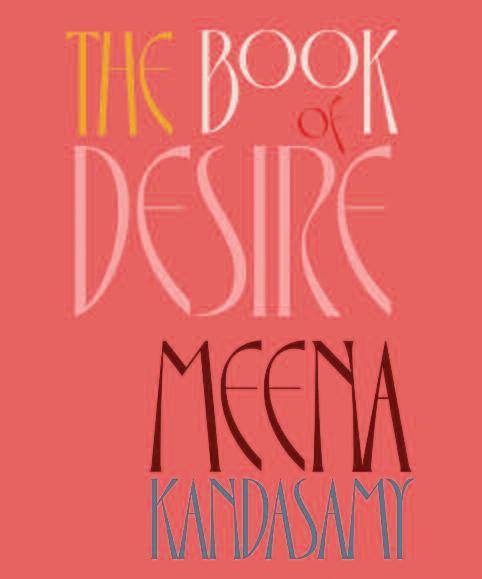
3 minute read
The Book of Desire
By Meena Kandasamy Galley Beggar Press, 2023
Reviewed by Isidora Duran
Stewar t
“The Book of D esire is pure love poetr y ” remarks Meena K andasamy in the introduc tion to her latest book , an English translation of the third book of the classic Tamil tex t, the Tirukkurral. Composed in the first centur y BCE and largely attributed to Tiruvalluvar, of whom few biographical details remain, the Tirukurral is a book of 1,330 verses divided into three sec tions concerning moralit y, materialism and desire. The third, the I npattuppal or K amattuppal, presents a dramatic telling of a relationship bet ween t wo anonymous lovers. Out of the three, it has been the most censored.
The Tirukkural was first translated into English 220 years ago and has passed through more than 100 iterations since, only one of which has been by a woman. K andasamy ’s is the first to take an internationist feminist approach. She weighs the words of previous translators and commentators, of ten proponents of the caste system with a distinc tly patriarchal agenda, and restores them to embody what the tex t has been long revered as: a celebration of female agenc y
K andasamy ’s work is revelator y, not just for the poetr y itself, but because it exposes the depths to which misogynistic ideas can be entrenched, and, like in the field of translation, for how long it can go unchallenged She ack nowledges this confluence in her introduc tion: “ The fault lines that run through societ y are the fault lines we see in scholarship.”
Each verse takes the metrical form of the kural – a couplet in which the first line consists of four feet and the second, three. The book consists of 250 kurals divided into 25 chapters with titles such as ‘Renouncing Shame’, ’ The Lament of Memor y ’ and ‘ The Delights of Sulking.’ The kural is unique to Tamil, the historical suppression of which Kandasamy centres in her introduction, asser ting that “entwined in this stor y is the stor y of the Tamil script ” The Brahminical caste, the highest within the caste system, has long referred to socialists should strive to do, thinking about what is being written and why is helpful, and this book cer tainly lends itself to that although, even at a bit more than 120 pages, the book could be more concise. The main substance is contained in one fifty page chapter in the middle of the book, and if one wanted only to absorb the book ’s key points, they could get them here. Perhaps not ever y argument made within necessarily holds up, but the majority of points are valid and well made n
Tamil as a ‘low language’. In the 10th centur y CE, a community of Brahmins who hereditarily control a prominent temple to this day, refused to par t from Tamil manuscripts that they had locked away until they came under significant pressure to do so – even though the request had come from the King
Today, Tamil is still forbidden to use in places of worship in Tamil Nudu, the southern most state of India.
“ Why speak of caste in a book that speaks of love?” –implores K andasamy “I f we exorcise the ghosts of British colonialism, are we [ Tamil speakers] content with a de -fac to second class status?” Af ter Britain’s selfser ving retreat from I ndia, and its bloody par tition of the sub - continent, the caste system – as well as all the other divisions it helped foster – remained The Tirukkural then, as a Tamil tex t, has long been in the hands of those whose interests lie in the preser vation of a system that is rife with inequalit y
K andasamy ’s inter ventionist approach is felt throughout. She explains in her introduc tion how she closed a sec tion break bet ween the first seven chapters and the 18 remaining The splitting of the I npattuppal, which can be seen in ever y Tamil volume still in print, was done to imply that the second half (which contains more erotically charged verses) took place af ter the marriage of the t wo lovers She upholds that removing such changes was paramount to eradicating a culture of misogyny that had been imposed upon the tex t
She approached the translation of Tamil to English through a semantic break- down of component words ( Tamil is an agglutinative language – it builds upon its root words) to first understand their meaning, before choosing the appropriate English. For example, the official translation of nirai is fullness, completeness, containment, but many previous editions rendered it to ‘chastit y ’ K andasamy chose ‘unwavering mind’ to invoke a sense of self-fulfillment: “ The battle -axe of passion / breaks down my door / of my unwavering mind / bolted with my coyness”
She also chose ‘man’, ‘woman’ and where possible, the gender-neutral ‘lover ’ over ‘husband’ and ‘wife’. Similarly, penniyalar ellarum had long been translated as ‘all women’, but she states that the Tamil meaning brings it closer to ‘womanlike / feminine’ She updated the verse accordingly : “ever yone with womanness / publicly feasts their eyes / but I will not embrace - / your debauched chest ” Comparing The Book of D esire










